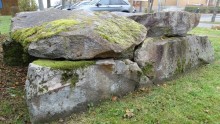|
|
|
|
Calden IAllee-Couverte
|
||||||||||||||||||
|
|
|
Images (click to view fullsize) |
|
Photographs:



 Maps / Plans / Diagrams:
Maps / Plans / Diagrams:


|
Fieldnotes |
|
|
Calden I (also known as the stone cist of Calden) is a megalithic site of the type gallery grave. The term gallery grave for German megalithic sites of a certain type ("long arcade") is a translation from the French (Allée couverte) and was due to the similarity of the German with East French sites. The tomb was discovered during plowing in 1947 and scientifically examined for the first time. In 1988, the new excavations were started as part of the Calden project. The discovered capstones of the stone cist were reconstructed on the southern outskirts of Calden. The tomb is actually quite nice, but unfortunately it is located directly opposite a school and a pole with a small information board was placed directly in front of the tomb, so that the general impression is rather mixed. The easiest way to find the tomb is to turn off at Schloss Wilhelmshöhe into the Lindenallee. At the end turn right into the street Zum Lindenrondell and follow it north to the end. Then turn left into the road Weserstraße. The grave is then about 250 m on the left side. Visited November 2019 |
4th November 2019ce Edited 4th November 2019ce |
|
taken from the on-site information board Eco Pfad Archäologie Calden: From the district Calden two gallery graves (also passage or stone chamber graves) are known. Tomb II lies in a westerly direction at the edge of the forest and was examined in 1990/1992. Tomb I was originally on the field of the farmer Georg Lückel, west of Calden. After the excavation, the stones were built at this point to a new ensemble. At the found location a wall stone was pulled out of the ground in 1947 because it bothered when plowing. According to a note from primary school teacher Justus Schüler from Calden an archaeological investigation took place here in 1948. It turned out that the tomb was badly destroyed even before its discovery. Pits filled with ceramics testify that in the first centuries after Christ birth people settled here and partially destroyed the grave. Also in the Middle Ages interventions took place. Nevertheless, the excavation was able to recover skeletal remains, finds and wall stones that give a picture of the original site. The burial chamber was more than 10 meters long and 2 meters wide. The entrance probably formed a large stone with a hole in it. Such "doorstones" (soul holes) are also from other graves, e.g. Züschen at Fritzlar, known. The differently sized wall stones were buried in the ground so that their upper edge reached about the same height. On it were capstones, as they were used in the reconstruction. Inside, there were numerous human bones, most of which were confused. Probably it was originally 100 to 200 buried persons. Her average age was 30 years. The men were between 1.59 m and 1.71 m tall, the body height of women varies between 1.46 m and 1.59 m. Among the grave goods the large number of arrowheads stands out. They are made of flint, which probably comes from the Baltic Sea, and local slate. The stone tips prove the addition of bow and arrow. The wooden components and bowstrings have passed in the ground. There were also some pierced animal teeth. They come from dogs, pigs, cattle, brown bears and wildcats. The animal teeth were worn as chain jewelery. The decoration of the ceramic found in the tomb and scientific methods allow a relatively accurate dating of the tomb. It was created between 3500 and 3400 BC. For about 200 years it was the burial place of a small village. |
4th November 2019ce Edited 4th November 2019ce |
Links |
|
Galeriegrab Calden I @ Eco Pfad Archäologie Caldenmore information on Calden I on the web site Eco Pfad Archäologie Calden (in German only) |
4th November 2019ce Edited 4th November 2019ce |

